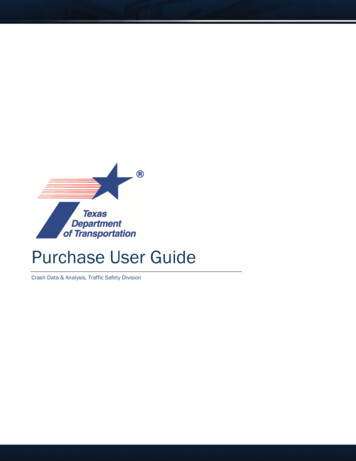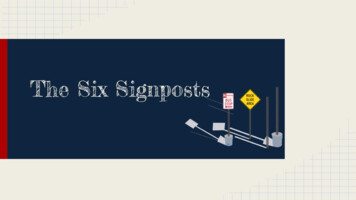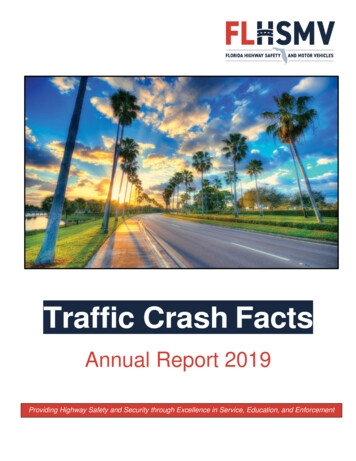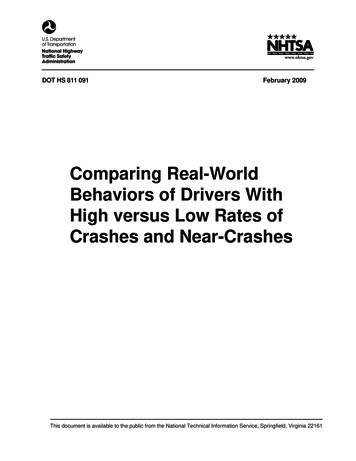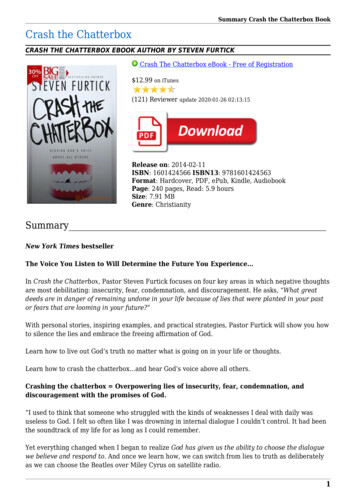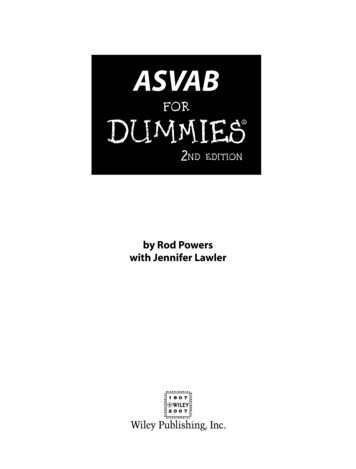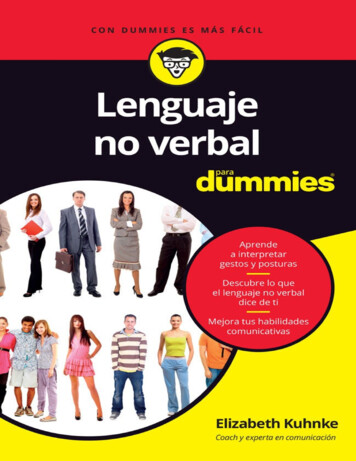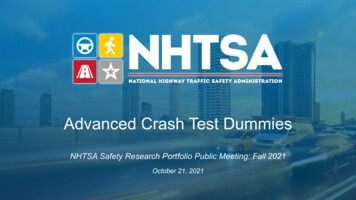
Transcription
Advanced Crash Test DummiesNHTSA Safety Research Portfolio Public Meeting: Fall 2021October 21, 2021
PanelPresentations1THOR-50M Update –Dan Parent2LODC Update –Jason Stammen3WorldSID-50M Update –Dan Rhule4RibEye Evaluation inWorldSID-50M –Heather Rhule
THOR-50M UpdateDan Parent
4THOR-50M Overview THOR Test Device for Human Occupant Restraint Provides improvements over the Hybrid III 50th percentilemale ATD Anthropomorphic Test Device (ATD) 50th percentile male (“THOR-50M”) More biofidelic (human-like) Enhanced instrumentation Increased injury prediction capability Used in NHTSA research projects dating back to 1999 Funded by NHTSA throughout development 250 tests in Vehicle Database 1,500 tests in Biomechanics Database
5THOR-50M Rulemakings Part 572 THOR-50M Crash Test Dummy March 2022 RIN: 2127-AM20 FMVSS No. 208 THOR-50M Compliance Option March 2022 RIN: 2127-AM21
6THOR-50M DocumentationTitleDescriptionDocket IDDefineATD TestMethodsFitnessDrawing PackageEngineering drawings describing detailed design, 2D and 3D s and response specifications in component and full bodyimpact testsNHTSA-2019-0106-0001PADIDescribes procedures for assembly, disassembly, inspection; serves asuser’s manual for a dummyNHTSA-2019-0106-0007Seating ProcedureEnsures repeatability in positioning the THOR in the driver or right frontpassenger seat for a crash testNHTSA-2019-0106-0006Injury CriteriaDescribes development of relationship between dummy measurementsand likelihood of injury, used to determine requirements or ratingsNHTSA-2019-0106-0008BiofidelityQuantitative comparison of THOR (and Hybrid III) to human vated-energy qualification tests to evaluate durability in repeated useNHTSA-2019-0106-0003R&R, Qualification5 of each qualification test on 3 different THORs, and 5 of eachqualification test on 1 THOR at 3 different labs to evaluate repeatabilityand reproducibilityTBD R&R, Oblique3 Oblique crash tests of the same vehicle make and model at 3 differenttest labs to ensure repeatability and reproducibility of crash test resultsNHTSA-2019-0106-0005 Docket ID NHTSA-2019-0106 NHTSA Crashworthiness Research – THOR-50M Documentation
7THOR-50M Qualification Updates Upper Leg Qualification Test12.00 kg witha 76.2 mmdiameter rigiddisk face Limitations of September 2018 procedure Comparatively high coefficient of variation Acetabulum force below meaningful injury risk Revisions Increased velocity to 3.30 m/s Increased mass to 12.0 kg (same as knee test) Added backer plate to restrain pelvisTest Velocity: 3.30 m/sBacker Plate Minor updates to clarify data processinginstructionsFor more information, see Millis, W., “An Improvement to theTHOR-50M Upper Leg Qualification Test Methodology” 2021SAE Government-Industry Digital Summit
8THOR-50M R&R (Qualification) Repeatability andReproducibility testing/analysisupdated to include revisedUpper Leg qualification test Results Improved qualitative andquantitative repeatability andreproducibility Coefficients of variation all below10%, many below 5% Acetabulum forces morerepresentative of crash testmeasurementsTest MatrixLab ATHOR-50M #15 L, 5 RTHOR-50M #25 L, 5 RTHOR-50M #35 L, 5 RSept 2018 Upper Leg TestLab BLab C5 L, 5 R5 L, 5 RRevised Upper Leg Test
9THOR-50M Injury CriteriaDocumentDocket IDPeer review chargeNHTSA-2020-0032-0001Peer reviewers and credentialsNHTSA-2020-0032-0002Draft submitted for peer reviewNHTSA-2020-0032-0003Peer review comments and NHTSA responsesNHTSA-2020-0032-0006Revised THOR-50M Injury Criteria ReportNHTSA-2020-0032-0004 Revisions based on peer review comments Updated critical intercepts in Nij calculationRemoved independent neck tension criterionHip fracture risk calculated when femur is in compressionRestored Revised Tibia Index criterionMinor updates to injury risk function form, pperTibiaForceLowerTibiaForceDocket ID NHTSA-2020-0032 Injury Criteria for the THOR 50th Male ATDAbdomenDeflectionAcetabulumForceTibia MomentRevised TibiaIndex
THOR-50M Assessment of Alternate Designs10Alternate ShoulderGold Standard 140 km/h, 14g pulse, standard 3-pt beltGold Standard 230 km/h, 9g pulse, 3kN LL 3-pt beltFlat seatKnee bolster to limit pelvis motionWire seatback to allow spine trackingAlternate DeflectionMeasurement DevicesIn-dummy DataAcquisition SystemVehicle BuckA) 20 Oblique, OMDB pulse fromsimilar mass vehicle, right frontpassengerB) 0 , FRB pulse, driverC) 0 , FRB pulse, right front passengerOEM interior, seats, restraint systemsVehicle Crash Tests (next slide)
11THOR-50M Crash TestsSpeed(km/h)# of DriverTHORs# of RFPTHORsVehicle Database Reference24, 32, 4099v10289-v10308OMDB90 100 100Test Type RMDB 15 DEGREE 35PERCENTFrontal Rigid Barrier56150Title RESEARCH FRONTAL RIGID BARRIER32, 4066v11083-v110944022Test ConditionBeltedSled with pass. car bodyUnbeltedSled with pass. car bodyFull FrontalLeft/Right Angled4044Angled (Durability)4833Title TO GENERATE 30 FRONTAL RIGIDBARRIER IMPACT PERFORMANCEINFORMATION
12THOR-50M Crash TestsSpeed(km/h)# of DriverTHORs# of RFPTHORs24, 32, 4099OMDB90 100 100Frontal Rigid Barrier5615032, 4066Full Frontal4022Left/Right Angled4044Angled (Durability)4833Test ConditionBeltedSled with pass. car bodyUnbeltedSled with pass. car bodyFMVSS No. 208 ConditionsFollowed THOR-50M Documentation(slide 3) THOR-50M ATDs according todrawing package, built per PADI All passing Qualification specs ATDs positioned per SeatingProcedure Conducted tests per FMVSS No.208 Data post-processing per PADI
13THOR-50M Crash TestsSpeed(km/h)# of DriverTHORs# of RFPTHORs24, 32, 4099OMDB90 100 100Frontal Rigid Barrier5615032, 4066Full Frontal4022Left/Right Angled4044Angled (Durability)4833Test ConditionBeltedSled with pass. car bodyUnbeltedSled with pass. car body
14THOR-50M Finite Element ModelAvailable through University of Virginia website nite-element-modelTHOR-50M FE Model Version 2.7
15LODC UpdateJason Stammen
#Large Omnidirectional Child (LODC) What is the LODC? NHTSA-developed child ATD with improvedbiofidelity & measurement capability Why do we need it? More comprehensive injury assessmentthan current child ATDs can provide What sets it apart from other child ATDs? Flexible spine Component responses matching pediatricdata (not data scaled from adults) Accurate anthropometry & anatomy16
#LODC Description Description of LODC and its features17
Neck can elongate and allowsfor free Z axis rotation; responsematching pediatric dataHead has inertial/massproperties matchingpediatric data18Sources: Dibb/Luck/Myers (Duke), Thunnissen1995Source: Loyd (Duke)Shoulders and thorax reflectpediatric anatomy and mimicpediatric responseSources: Kent/Parent (UVA), Maltese (CHOP),Agnew/Bolte (OSU)Flexible cervicothoracic& thoracic spine for morebiofidelic head trajectoryand neck loadsBiofidelic, instrumentedabdomen to measure beltinduced loadingSources: Kang (OSU), LopezValdes/Ash (UVA), Arbogast (CHOP),Pintar/Yoganandan (MCW)Sources: Kent (UVA), Beillas (IFSTTAR)Ramachandra (OSU), Hardy (Wayne State)Anthropometry matchesactual seated child dataSource: Reed (UMTRI)
#LODC Specifications ATD specifications (PADI,drawing package,qualification procedures,soft part tooling CAD,manufacturing guidancemanual) Evaluation of draftspecifications underwaythrough an IDIQ contractto build a productionintent LODC Documentation to beposted19
#Durability and R&R Now that initial development iscomplete, evaluating durability,repeatability, and reproducibility(1) Durability series just completed – nodamage and response returned tobaseline each time(2) R&R is next – five repeat componenttests on three LODC’s Full scale R&R in sled/crash testsincluding externally-built LODCsexpected to complete next year20
#Abdomen & Thorax Injury Risk Functions Using a combination of pediatricbiomechanical data, injury data, and ATDtests, we derived injury risk functions foruse in evaluating restraint systems withLODC1RiskLevelVmax*CmaxPressure(AIS 2 Thorax Injury) (AIS 3 Abdomen Injury)10%0.42 m/s69.3 kPa25%0.43 m/s84.7 kPa50%0.45 m/s114.5 kPa1Suntayet al. “Abdominal and Thoracic Injury Risk Functions forthe Large Omni-directional Child (LODC) ATD” (IRCOBI 2021)21
#Injury Assessment: Abdomen Abdomen injuries due to lap beltintrusion common for olderchildren LODC uses pressure sensors (leftand right) to measure abdomenloading The sensors have been shown todistinguish between restraintconditions - Booster seats result in pressures 75 kPa No longer have to rely on indirector qualitative measures to monitorsubmarining22
#Injury Assessment: Thorax Thoracic organ injuries areoften serious in children Continuing development oflaser chest deflection system Confirmed accuracy ofmeasurement and that laserlocation on sternum ismaintained within 2 cm ofinitial position during 3-pt beltloading Evaluating durability of thelaser module (some evidenceof signal degradation overmultiple impacts)23
24Injury Assessment: Head/Brain Traumatic brain & skull injuries are the most common serious injuries sustained by children in MVCs.1We do have pediatric HIC, but we don’t have brain rotational injury criteria (BrIC).Similar to the development of adult BrIC, NHTSA is working on defining pediatric BrIC using FEM, animalmodels, ATD testing, and real-world crash data.Objective: Link pediatric head kinematics (LODC) to injury risk.LODC head impacts at a variety of speeds & directions scheduled for late 2021.Finite Element ModelATD DataInjury RiskInjury Data From Animal Models(rhesus monkeys, baboons, miniature pigs)BrIC1. Arbogast, K., et al. 2005. Predictors and Patterns of Pediatric Head Injury in Motor Vehicle Crashes. IRCOBI; Prague.𝑩𝑩𝑩𝑩𝑩𝑩𝑩𝑩 𝝎𝝎𝒚𝒚 𝟐𝟐𝝎𝝎𝒙𝒙 𝟐𝟐𝝎𝝎 𝟐𝟐 ��𝒚𝝎𝝎𝒛𝒛𝒛𝒛
25Pediatric Shoulder Biofidelity Adapting Tornvall et al.(2005)1 test setup topediatric volunteers Volunteer testingongoing (about ½ waythrough – 12 of 24completed) Biofidelity assessment ofLODC shoulder Papers forthcomingFrom: Tornvall, et al. (2005) “Comparison of shoulder range-of-motionand stiffness between volunteers, Hybrid III and THOR Alpha in staticfrontal impact loading” International Journal of Crashworthiness, 10:2,151-160.
#LODC FE Model FE model: validate vs.experimental data Using the model to evaluatepart performance & developnew qualification tests Built a model of the updatedFMVSS No. 213 test benchto help with restraintevaluation Model will be publiclyavailable26
#27Seating Procedure We are developing a seating procedure with two goals: (1) realisticand (2) repeatableT6 0.0 /- 1.0 Head 0.0 /- 2.0 Pelvis 32.0 /- 2.0 1Louden.“Large Omni-directional Child(LODC) Seating Evaluation” (SAE GI 2021)
28Summary NHTSA developed LODC to address limitations with Hybrid III 10YO Current activities are focused on(1)(2)(3)(4)(5)(6)(7)Finalizing dummy specification documentsEvaluating the LODC’s durability, repeatability, and reproducibilityFinalizing chest deflection systemDeriving injury risk functionsGenerating shoulder biofidelity targets and evaluating the LODC shoulderBuilding a computational model & using it to evaluate part performanceDeveloping a seating procedureFor more information, see Docket ID NHTSA-2019-0110 NHTSA Crashworthiness Research – LODC Documentation
29WorldSID-50MDan Rhule
30WorldSID-50M Overview WorldSID Worldwide harmonized Side Impact Dummy Anthropomorphic Test Device (ATD) 50th percentile male (WorldSID-50M) Provides improvements over the ES-2re More biofidelic (human-like) Enhanced instrumentation Increased injury prediction capability Used in NHTSA research since 2005 77 crash tests 1,800 component-level tests
31WorldSID-50M Rulemakings Part 572 WorldSID-50M Crash Test Dummy Long-term actionRIN: 2127-AM22 FMVSS No. 214 WorldSID-50M Compliance Option Long-term actionRIN: 2127-AM23
32WorldSID-50M thodsFitnessDrawing PackageEngineering drawings describing detailed designIn process – finalizingRibEye details QualificationProcedures and response specifications in component and full bodyimpact testsIn process – may addsingle-arm impact PADIDescribes procedures for assembly, disassembly, inspection; serves asuser’s manual for a dummyIn process Seating ProcedureEnsures repeatability in positioning the WSID-50M in the driver or rightfront passenger seat for a crash testNHTSA-2019-01080003 Injury CriteriaDescribes development of relationship between dummy measurementsand likelihood of injury, used to determine requirements or ratingsIn process BiofidelityQuantitative comparison of WSID-50M to human response corridorsNHTSA-2019-01080001 DurabilityElevated-energy qualification tests to evaluate durability in repeated useDraft complete – inAgency circulation R&R,Qualification1VRTC: 5 repeats of each qualification test on 3 different WSID-50Ms;Outside labs: 5 repeats of each qualification test on 1 WSID-50M at 3 different labs to evaluate repeatability and reproducibility of resultsDraft complete – inAgency circulation R&R, Sled13 repeat tests of 2 WSID-50M dummies in 4 configurationsDraft complete – inAgency circulation 1Qualificationand Sled R&R are combined in a single reportDocket ID NHTSA-2019-0108 NHTSA Crashworthiness Research – WorldSID-50M Documentation
33WorldSID-50M Single-Arm Impact Test Dummy’s arm plays an important role in side impactresponse NHTSA is considering a qualification procedure for thedummy’s arm, tested by itself, removed from thedummy Full-body thorax with arm test doesn’t differentiate betweenarm response and thorax response VRTC has developed a test procedure (available tointerested parties) Limited lab-to-lab R&R series with Humanetics ATD Established preliminary response corridors Need additional testing More sample arms More test labs
34WorldSID-50M Temperature Sensitivity Historically, NCAP and Reg. Tests require temperaturerange of 69-72o F Onboard DAS and RibEye controller generate heatwhich is trapped inside the dummy by its suit VRTC testing demonstrated that response variationassociated with the dummy’s internal temperature ismuch less than the range of responses observed inLab-to-Lab R&R tests conducted at 69-75o F VRTC is recommending an allowable range of 69-75o Ffor qualification and vehicle crash tests Additionally, we have successfully used a vacuumsystem to help control the dummy’s internaltemperature during testing
35WorldSID-50M Vehicle Crash Tests Crash tests with MY2019/2020 vehicles FMVSS 214 Oblique pole (20 mph) FMVSS 214 MDB (33.5 mph) WorldSID-50M used was a standard buildlevel F with the following modifications RibEye Multipoint Deflection MeasurementSystem Sleeveless suit Split thorax pads Modified shoulder pads In-Dummy DTS G5 Data Acquisition System
36WorldSID-50M Vehicle Crash Tests 16 Total Crash Tests All tests followed NHTSA seating procedures andFMVSS 214 test procedures No significant issues with instrumentationresponses WorldSID 50th male ATD was durable in thecrash tests No major damage seen on the dummy (brokenankle on one vehicle model) No issues with RibEye LEDs or sensors 8 Total Qualifications- overall good dataresponse Majority of qualifications had no issue with testsetup and meeting test response requirements
37RibEye Evaluation in WorldSID-50MHeather Rhule
38Single point chest deflection instrumentation
39Single Point Chest Deflection TRACC(Infrared TelescopingRod for Assessment ofChest Compression)WorldSID
40Single Point Chest Deflection onwill underestimateinjury risk duringoblique loading
41Oblique chest loading in crash tests
42Oblique Chest Loading In Pole Crash Tests350Max Deflection v3300250250250200150100500200Anterior-Posterior Position (mm)Anterior-Posterior Position -200-1000150100500-50100-250-200Lateral-Medial Position (mm)Lateral-Medial Position (mm)-150-100350350InitialInitialMax Deflection v3300Max Deflection 150-100-50Lateral-Medial Position (mm)050100150-50Lateral-Medial Position (mm)Anterior-Posterior Position (mm)-250Anterior-Posterior Position (mm)Anterior-Posterior Position (mm)Initial positionMax deflectionInitialMax Deflection v3300Max Deflection 50-100-50Lateral-Medial Position (mm)050100150050100150
43RibEye in WorldSID-50MWhat is it?
44RibEye Multi-point Optical Measurement System WorldSID-50Mo X, Y, Z positions of 18 pointso 2 sets of: [3 sensors & 9 LEDs] Top set red filters & red LEDs Bottom set blue filters & blue LEDsFront Each set: Origin is at center of lens ofmiddle sensoro 3 LEDs on each ribo All 3 sensors must sense light from an LEDto measure its positionSide ViewShdr RibThx Rib 1Thx Rib 2Thx Rib 3Abdomen Rib 1Abdomen Rib 2Origin
RibEye Multi-point Optical Measurement SystemsensorsLEDs45
46RibEye in WorldSID-50MOptimal RibEye LED Trio
47Optimal RibEye LED Trio YLED locationsDeflection Missed (mm) XLargestdeflections“missed” by theIR-TRACCAvg error (mm) Max error (mm)LED trio1.1-1.49Middle LED only4.723“Determination of Optimal RibEye LED Locations in The WorldSID 50th Percentile Male Dummy” DOT HS 812 /www.regulations.gov/search?filter NHTSA-2019-0108
48RibEye in WorldSID-50MResults of our testing
49RibEye Cable RoutingGood cablemanagementPoor cablemanagementHeatshrinktomanagecablesCable ties formanagingcablesCable tie forbundlingCable tiemountCable routing procedures available upon request from heather.rhule@dot.govCableholder
Shoulder Pad Design ChangeOriginal shoulder padPost-crash – shoulder pad lodged inshoulder rib, blocking LED signals50
51Shoulder Pad Design ChangeNew shoulder padDesigned toprevent pad fromlodging insideshoulder ribFront viewBottom viewShoulder pad drawings and CAD models: https://www.nhtsa.gov/file-downloads?p nhtsa/downloads/WorldSID-50M/
Oblique Chest Loading In Pole Crash TestsWorldSID-50MdriverInitial positionMax deflection52
53Oblique Chest Loading In Pole Crash TestsWorldSID-50MdriverInitial positionMax deflectionFrnt 39Mid 41Rear 23Frnt 37Mid 33Rear 18Frnt 42Mid 40Rear 22Frnt 61Mid 40Rear 13Frnt 61Mid 44Rear 18
54Oblique Chest Loading In Pole Crash TestsWorldSID-50MdriverInitial positionMax deflectionFrnt 39Mid 41Rear 23Frnt 37Mid 33Rear 18Frnt 42Mid 40Rear 22Frnt 61Mid 40Rear 13Frnt 61Mid 44Rear 18
55Oblique Chest Loading In Pole Crash TestsWorldSID-50MdriverInitial positionMax deflectionFrnt 39Mid 41Rear 23Frnt 37Mid 33Rear 18Frnt 61Mid 40Rear 13Front LED, 61 mm:Risk AIS 3 64%Middle LED, 40-44 mm:Risk AIS 3 8%Frnt 42Mid 40Rear 22Frnt 61Mid 44Rear 18
56RibEye in WorldSID-50MRibEye data plots
57RibEye Data Plots – Length Change210114 Pole testMaximum (mm)Shoulder rear LEDShoulder middle LEDShoulder front LED12.7542.9751.95705040ChannelThorax Rib 1 Rear LEDThorax Rib 1 Mid LEDThorax Rib 1 Front LEDThorax Rib 2 Rear LEDThorax Rib 2 Mid LEDThorax Rib 2 Front LEDThorax Rib 3 Rear LEDThorax Rib 3 Mid LEDThorax Rib 3 Front LED60504070Maximum ength Change (mm)60ChannelLength Change (mm)Length Change houlder708090100Time (ms)-1001020304050Thorax60708090100Time (ms)-1001020ChannelMaximum (mm)Abdomen Rib 1 Rear LEDAbdomen Rib 1 Middle LEDAbdomen Rib 1 Front LEDAbdomen Rib 2 Rear LEDAbdomen Rib 2 Middle LEDAbdomen Rib 2 Front 8090100Time (ms)
58RibEye Data Plots – X vs. Y Position150125100755025X (mm)X (mm)210114 Pole testShoulder Rear LEDShoulder Middle LEDShoulder Front LEDThorax Rib 1 Rear LEDThorax Rib 1 Middle LEDThorax Rib 1 FrontLEDThorax Rib 2 Rear LEDThorax Rib 2 Middle LEDThorax Rib 2 Front LED0125range100755025sensor-251500-25Thorax Rib 3 Rear LEDThorax Rib 3 Middle LEDThorax Rib 3 Front LEDAbdomen Rib 1 Rear LED-75Abdomen Rib 1 Middle LED-100Abdomen Rib 1 Front LEDAbdomen Rib 2 Rear LED-125Abdomen Rib 2 Middle LEDAbdomen Rib 2 Front LED-150-120 -110 -100 -90 -80 -70 -60 -50 -40 -30 -20 -10 0 10Y (mm)-50-50-75range-100-125-150-120 -110 -100 -90 -80 -70 -60 -50 -40 -30 -20 -10Upper group0 10Y (mm)Lower groupsensor
59RibEye Data Plots – Y vs. Z Position12010080604020Shoulder Rear LEDShoulder Middle LEDShoulder Front LEDThorax Rib 1 Rear LEDThorax Rib 1 Middle LEDThorax Rib 1 Front LEDThorax Rib 2 Rear LEDThorax Rib 2 Middle LEDThorax Rib 2 Front LEDZ (mm)Z (mm)210114 Pole 00-120-120rangeUpper group0 10Y (mm)sensor-20-40-140-120 -110 -100 -90 -80 -70 -60 -50 -40 -30 -20 -10Thorax Rib 3 Rear LEDThorax Rib 3 Middle LEDThorax Rib 3 Front LEDAbdomen Rib 1 Rear LEDAbdomen Rib 1 Middle LEDAbdomen Rib 1 Front LEDAbdomen Rib 2 Rear LEDAbdomen Rib 2 Middle LEDAbdomen Rib 2 Front LEDrange-140-120 -110 -100 -90 -80 -70 -60 -50 -40 -30 -20 -10Lower group0 10Y (mm)
60RibEye in WorldSID-50MExamples of error codes
61Example 1: Data out of range201022 Pole test – Thorax rib 1Length Change6050ChannelMaximum (mm)Thorax Rib 1 Rear LEDThorax Rib 1 Middle LEDThorax Rib 1 Front LED32.4831.5514.54150125100Thorax Rib 1 Rear LEDThorax Rib 1 Middle LEDThorax Rib 1 FrontLED75Error code 9:out of range40X (mm)Length Change (mm)70X vs. Y PositionMax 08090100Time (ms)Error code 9:out of range-150-120 -110 -100 -90 -80 -70 -60 -50 -40 -30 -20 -100 10Y (mm)
62Example 2: One thorax rib blocks another thorax rib210408 Pole test – Thorax RibsLength Change (mm)70ChannelThorax Rib 1 Rear LEDThorax Rib 1 Mid LEDThorax Rib 1 Front LEDThorax Rib 2 Rear LEDThorax Rib 2 Mid LEDThorax Rib 2 Front LED6050Maximum (mm)26.5640.4140.2320.0323.4716.44CAD model @ 50.5 msMax deflShoulder RibTop sensorError code 1:top sensorblocked4030Thx Rib 120Middle sensor10Thx Rib 20-100102030405060708090100Time (ms)Bottom sensorRear MidFront
63Example 3: Shoulder rib blocks Thorax Rib 1210422 Pole testCAD model @ 42.2 msThorax Rib 1Length Change (mm)70ChannelTop sensorMaximum (mm)Thorax Rib 1 Rear LED 25.26Thorax Rib 1 Mid LED 34.25Thorax Rib 1 Front LED 27.166050Shoulder RibShoulderLoad Cell40Partial blockage302010Middle sensor0Error Code 1:top sensorblocked-10-20-30Thx Rib 10102030405060708090100Time (ms)Bottom sensorThx Rib 2
Example 4: Shoulder rib DOES NOT block Thorax Rib 1210915 Pole test: 210422 repeat, LEDs moved70Length Change (mm)210422 Pole test64Thorax Rib 1 Rear LED 27.57Thorax Rib 1 Mid LED36.88Thorax Rib 1 Front LED 35.606050No blockages onThorax rib 1;max deflectionobtained403020100-10-20-30-10CAD model @ 42.2 msCAD model @ 35.5 ms0102030405060708090 100Time (ms)CAD model @ 35.5 msShoulder RibShoulderLoad CellThx Rib 1Thx Rib 2
65Summary Single point chest deflection instrumentation will underestimate injury risk during oblique chestloading; oblique chest loading has been observed in crash tests The value of RibEye measuring multiple points of deflection was demonstrated in crash testswhere the injury risk difference from the middle LED was 56%. Thorax and abdomen RibEye error codes caused by LEDs exceeding the sensor range areinconsequential as long as at least one LED per rib stays in range RibEye signal blockages caused by one thorax rib deflecting more than another thorax rib arenot important Thorax rib 1 LEDs will now be located at the bottom of the rib WorldSID-50M with RibEye is a feasible tool for FMVSS/NCAP Report on RibEye evaluation to be docketed
66Thank you for your time and attentionDan Parent:Jason Stammen:Dan Rhule:Heather hule@dot.govheather.rhule@dot.gov
Advanced Crash Test Dummies NHTSA Safety Research Portfolio Public Meeting: Fall 2021 October 21, 2021. Panel Presentations . Building a computational model & using it to evaluate part performance (7) Developing a seating procedure For more information, see Docket ID NHTSA-2019-0110
